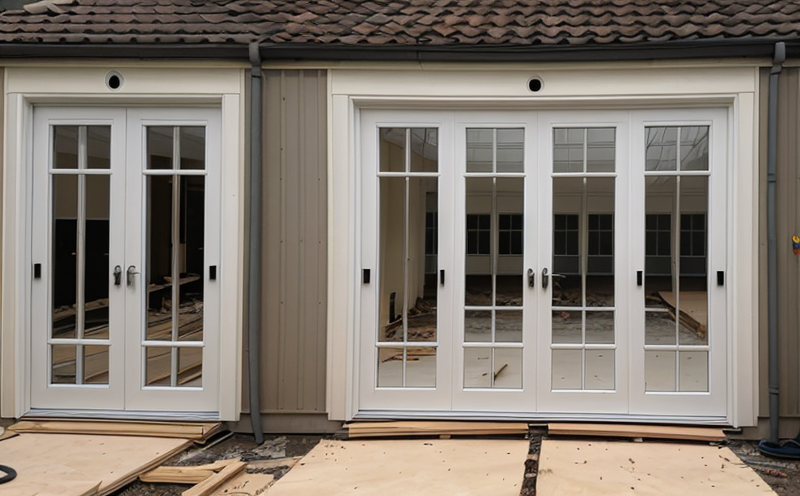Fire Endurance Testing of Movable Walls
The fire endurance testing of movable walls is a critical procedure in ensuring that materials and assemblies used within buildings meet stringent safety standards. This test evaluates how well the wall performs under extreme temperatures and heat exposure, which can be vital to preventing the spread of fires. The test focuses on the ability of the wall to maintain its structural integrity and resist fire for a specified period.
The testing process is designed to mimic real-world conditions that might arise during a fire emergency. This includes subjecting the wall to high temperatures and flames, monitoring how it behaves over time, and assessing any potential breaches or failures in insulation or structure. The goal of this test is not only to ensure compliance with local building codes but also to provide valuable insights into the performance characteristics of materials that can be used in construction.
Compliance officers must understand these tests because they are essential for ensuring that all building components meet safety regulations. Quality managers need accurate and consistent data from these tests to make informed decisions about which products should be approved or rejected. R&D engineers rely on this information when developing new materials or improving existing ones, while procurement teams use it to select suppliers whose products meet the necessary standards.
The test setup involves placing a sample of the wall in a furnace where temperatures can reach up to 1000°C (1832°F), depending on the code requirements. The duration of exposure varies but typically lasts between 30 minutes and 6 hours, again based on local regulations or client specifications. During this time, observers carefully watch for signs that might indicate failure such as structural collapse, loss of insulation effectiveness, or increased flame spread.
Once testing is complete, engineers analyze the results to determine whether the wall passed or failed based on predefined criteria outlined in relevant standards like ASTM E119 or ISO 8404. If it passes, this indicates that under simulated fire conditions, the wall was able to maintain its integrity and provide adequate protection from heat and flame for the required period.
Understanding why such testing is important helps explain the broader context of fire safety in buildings. By knowing exactly what goes into these tests—such as temperature levels, exposure times, and evaluation methods—you can better appreciate their significance in safeguarding lives and property against potential disasters caused by fires.
Why It Matters
The fire endurance testing of movable walls is essential because it ensures that the materials used are capable of providing effective protection during a fire. In commercial buildings, industrial facilities, public spaces, or even residential properties, walls play an important role in containing flames and smoke within specific areas until firefighters arrive on scene.
When properly tested according to recognized standards like ASTM E119 for building construction materials, these tests help identify any weaknesses that could compromise safety during emergencies. For example, if a wall fails after only 30 minutes of exposure despite being expected to hold up much longer, this would suggest there are issues with either the design or manufacturing process that need addressing before widespread use.
Moreover, passing this type of test serves as proof that your product meets stringent performance levels required by law. This certification can give you a competitive edge in bidding for contracts because potential clients will trust that they’re getting reliable products from trusted manufacturers who adhere to high standards.
Why Choose This Test
Selecting fire endurance testing for movable walls is wise due to several reasons. First and foremost, it provides assurance about the product's reliability when faced with severe conditions such as fires. By undergoing rigorous testing procedures, you can rest assured that your wall will perform as intended during emergencies.
Additionally, successful completion of these tests enhances brand reputation among consumers who value safety above all else. Potential buyers are more likely to purchase products from companies known for producing safe and dependable goods. This increased demand can lead to higher sales figures and greater market share.
Furthermore, compliance with regulatory requirements is crucial in avoiding legal issues down the line. Non-compliance could result in hefty fines or even closure of operations if found out by authorities during inspections. Conducting thorough testing ensures that all necessary criteria are met well ahead of time so there’s no risk of non-conformance.
Lastly, investing in quality control measures like fire endurance testing demonstrates commitment to excellence among employees and stakeholders alike. It fosters a culture where everyone is focused on delivering top-notch products consistently across all projects undertaken by the company.
Environmental and Sustainability Contributions
The fire endurance testing of movable walls contributes significantly to environmental sustainability efforts in several ways. One key aspect is reduced risk of accidental fires, which helps prevent unnecessary resource consumption associated with firefighting operations such as water usage and energy expenditure.
By ensuring that walls meet strict performance standards, this type of testing also promotes the use of eco-friendly materials that have lower embodied carbon footprints compared to alternatives. This reduces overall greenhouse gas emissions during manufacturing processes and throughout a building's lifecycle.
In addition, successful completion of these tests encourages innovation in material science by driving research towards developing more resilient and sustainable options for wall constructions. As companies strive to meet ever-evolving standards, they are compelled to explore new technologies that offer improved performance while minimizing environmental impact.
Finally, the information gained from fire endurance testing can be utilized to optimize building designs so that they require fewer resources during construction and operation phases. For instance, understanding how different wall types behave under extreme heat allows architects to choose those most appropriate for specific applications thus reducing waste.





